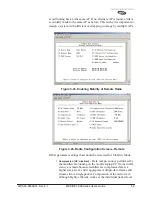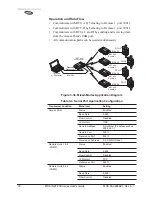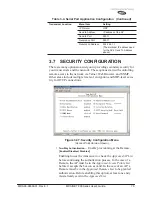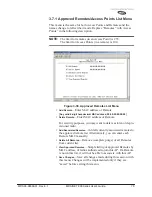
MDS 05-2806A01, Rev. E.1
MDS iNET 900 Series User’s Guide
67
•
Status
—Enable/Disable the serial data port.
•
IP Protocol
—PPP. This is the type of IP port that will be offered
by the transceiver’s serial device server. [
TCP, UDP, PPP; TCP
]
•
Device IP Address
—IP address that will be assigned to the dialing
device once the connection is established. [
0.0.0.0
]
•
Data Baud
—The baud rate of the serial port of the transceiver to
which the external device is connected.
[
1200, 2400, 4800, 9600, 19200, 38400, 57600, 115200; 19200
]
•
Configuration
—Byte format of the serial port
[
7N1, 7E1, 701, 7N2, 7E2, 702, 8N1, 801, 8N2, 8E2, 802; 8N1
]
•
Flow Control
(COM2 only)—RTS/CTS handshaking between the
transceiver and the connected device.
[
Enable, Disable; Disabled
]
•
Serial Mode
—When seamless mode is selected, data bytes will be
sent over the air as quickly as possible, but the receiver will
buffer the data until enough bytes have arrived to cover worst
case gaps in transmission. The delay introduced by data buffer-
ing may range from 22 to 44 ms, but the radio will not create any
gaps in the output data stream. This mode of operation is
required for protocols such as MODBUS™ that do not allow
gaps in their data transmission. [
Seamless, Custom; Seamless
]
•
Seamless Inter-Frame Delay
— Number of characters that represent
the end of a message (inter-character time-out). MODBUS
defines a “3.5-character” parameter. [
1–65,535; 4
]
•
Custom Data Buffer Size
(Custom Packet Mode only)—Maxi-
mum amount of characters, that the Remote end will buffer
locally before starting to transmit data through the serial port.
[
16, 32, 64, 128, 256; 32
]
•
Commit Changes and Exit Wizard
—Save and execute changes made
on this screen (Shown only after changes have been entered.)
A PPP session shows the following possible states:
•
Sending LCP Requests
—The PPP server is querying for any cli-
ents that need to connect.
•
Link Established
—A successful PPP connection has been negoti-
ated and an IP address is assigned.
•
Port not Enabled
—The serial port is disabled.
3.6.6 IP-to-Serial Application Example
You have a choice to use UDP or TCP to establish communications.
This will depend on the type of device you are communicating with at
the other end of the IP network. In this example we will use TCP to illus-
trate its use.
In TCP mode, the transceiver remains in a passive mode offering a
socket for connection. Once a request is received, data received at the
serial port will be sent out through the IP socket and vice versa, until the
Содержание iNET 900 Series
Страница 10: ...2 MDS iNET 900 Series User s Guide MDS 05 2806A01 Rev E 1 ...
Страница 26: ...18 MDS iNET 900 Series User s Guide MDS 05 2806A01 Rev E 1 ...
Страница 118: ...110 MDS iNET 900 Series User s Guide MDS 05 2806A01 Rev E 1 ...
Страница 120: ...112 MDS iNET 900 Series User s Guide MDS 05 2806A01 Rev E 1 ...
Страница 136: ...128 MDS iNET 900 Series User s Guide MDS 05 2806A01 Rev E 1 ...
Страница 148: ...140 MDS iNET 900 Series User s Guide MDS 05 2806A01 Rev E 1 ...
Страница 150: ...142 MDS iNET 900 Series User s Guide MDS 05 2806A01 Rev E 1 ...
Страница 164: ...156 MDS iNET 900 Series User s Guide MDS 05 2806A01 Rev E 1 ...
Страница 172: ...164 MDS iNET 900 Series User s Guide MDS 05 2806A01 Rev E 1 ...
















































